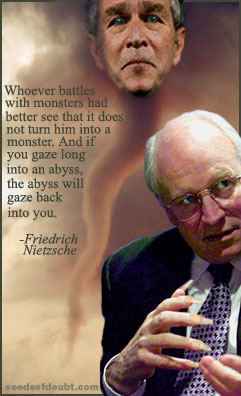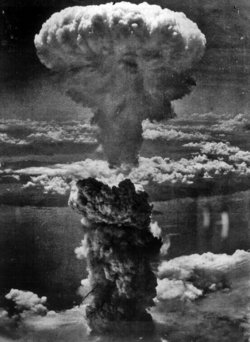Washington
DEEP in a remote, fog-layered hollow near Sugar Grove, W.Va., hidden by fortress-like mountains, sits the country's largest eavesdropping bug. Located in a "radio quiet" zone, the station's large parabolic dishes secretly and silently sweep in millions of private telephone calls and e-mail messages an hour.
Run by the ultra-secret National Security Agency, the listening post intercepts all international communications entering the eastern United States. Another N.S.A. listening post, in Yakima, Wash., eavesdrops on the western half of the country.
A hundred miles or so north of Sugar Grove, in Washington, the N.S.A. has suddenly taken center stage in a political firestorm. The controversy over whether the president broke the law when he secretly ordered the N.S.A. to bypass a special court and conduct warrant-less eavesdropping on American citizens has even provoked some Democrats to call for his impeachment.
According to John E. McLaughlin, who as the deputy director of the Central Intelligence Agency in the fall of 2001 was among the first briefed on the program, this eavesdropping was the most secret operation in the entire intelligence network, complete with its own code word - which itself is secret.
Jokingly referred to as "No Such Agency," the N.S.A. was created in absolute secrecy in 1952 by President Harry S. Truman. Today, it is the largest intelligence agency. It is also the most important, providing far more insight on foreign countries than the C.I.A. and other spy organizations.
But the agency is still struggling to adjust to the war on terror, in which its job is not to monitor states, but individuals or small cells hidden all over the world. To accomplish this, the N.S.A. has developed ever more sophisticated technology that mines vast amounts of data. But this technology may be of limited use abroad. And at home, it increases pressure on the agency to bypass civil liberties and skirt formal legal channels of criminal investigation. Originally created to spy on foreign adversaries, the N.S.A. was never supposed to be turned inward. Thirty years ago, Senator Frank Church, the Idaho Democrat who was then chairman of the select committee on intelligence, investigated the agency and came away stunned.
"That capability at any time could be turned around on the American people," he said in 1975, "and no American would have any privacy left, such is the capability to monitor everything: telephone conversations, telegrams, it doesn't matter. There would be no place to hide."
He added that if a dictator ever took over, the N.S.A. "could enable it to impose total tyranny, and there would be no way to fight back."
At the time, the agency had the ability to listen to only what people said over the telephone or wrote in an occasional telegram; they had no access to private letters. But today, with people expressing their innermost thoughts in e-mail messages, exposing their medical and financial records to the Internet, and chatting constantly on cell-phones, the agency virtually has the ability to get inside a person's mind.
The N.S.A.'s original target had been the Communist bloc. The agency wrapped the Soviet Union and its satellite nations in an electronic cocoon. Anytime an aircraft, ship or military unit moved, the N.S.A. would know. And from 22,300 miles in orbit, satellites with super-thin, football-field-sized antennas eavesdropped on Soviet communications and weapons signals.
Today, instead of eavesdropping on an enormous country that was always chattering and never moved, the N.S.A. is trying to find small numbers of individuals who operate in closed cells, seldom communicate electronically (and when they do, use untraceable calling cards or disposable cell-phones) and are constantly traveling from country to country.
During the cold war, the agency could depend on a constant flow of American-born Russian linguists from the many universities around the country with Soviet studies programs. Now the government is forced to search ethnic communities to find people who can speak Dari, Urdu or Lingala - and also pass a security clearance that frowns on people with relatives in their, or their parents', former countries.
According to an interview last year with Gen. Michael V. Hayden, then the N.S.A.'s director, intercepting calls during the war on terrorism has become a much more complex endeavor. On Sept. 10, 2001, for example, the N.S.A. intercepted two messages. The first warned, "The match begins tomorrow," and the second said, "Tomorrow is zero hour." But even though they came from suspected Al Qaeda locations in Afghanistan, the messages were never translated until after the attack on Sept. 11, and not distributed until Sept. 12.
What made the intercepts particularly difficult, General Hayden said, was that they were not "targeted" but intercepted randomly from Afghan pay phones.
This makes identification of the caller extremely difficult and slow. "Know how many international calls are made out of Afghanistan on a given day? Thousands," General Hayden said.
Still, the N.S.A. doesn't have to go to the courts to use its electronic monitoring to snare Al Qaeda members in Afghanistan. For the agency to snoop domestically on American citizens suspected of having terrorist ties, it first must to go to the Foreign Intelligence Surveillance Court, or FISA, make a showing of probable cause that the target is linked to a terrorist group, and obtain a warrant.
The court rarely turns the government down. Since it was established in 1978, the court has granted about 19,000 warrants; it has only rejected five. And even in those cases the government has the right to appeal to the Foreign Intelligence Surveillance Court of Review, which in 27 years has only heard one case. And should the appeals court also reject the warrant request, the government could then appeal immediately to a closed session of the Supreme Court.
Before the Sept. 11 attacks, the N.S.A. normally eavesdropped on a small number of American citizens or resident aliens, often a dozen or less, while the F.B.I., whose low-tech wiretapping was far less intrusive, requested most of the warrants from FISA.
Despite the low odds of having a request turned down, President Bush established a secret program in which the N.S.A. would bypass the FISA court and begin eavesdropping without warrant on Americans. This decision seems to have been based on a new concept of monitoring by the agency, a way, according to the administration, to effectively handle all the data and new information.
At the time, the buzzword in national security circles was data mining: digging deep into piles of information to come up with some pattern or clue to what might happen next. Rather than monitoring a dozen or so people for months at a time, as had been the practice, the decision was made to begin secretly eavesdropping on hundreds, perhaps thousands, of people for just a few days or a week at a time in order to determine who posed potential threats.
Those deemed innocent would quickly be eliminated from the watch list, while those thought suspicious would be submitted to the FISA court for a warrant.
In essence, N.S.A. seemed to be on a classic fishing expedition, precisely the type of abuse the FISA court was put in place to stop. At a news conference, President Bush himself seemed to acknowledge this new tactic. "FISA is for long-term monitoring," he said. "There's a difference between detecting so we can prevent, and monitoring."
This eavesdropping is not the Bush administration's only attempt to expand the boundaries of what is legally permissible.
In 2002, it was revealed that the Pentagon had launched Total Information Awareness, a data mining program led by John Poindexter, a retired rear admiral who had served as national security adviser under Ronald Reagan and helped devise the plan to sell arms to Iran and illegally divert the proceeds to rebels in Nicaragua.
Total Information Awareness, known as T.I.A., was intended to search through vast data bases, promising to "increase the information coverage by an order-of-magnitude." According to a 2002 article in The New York Times, the program "would permit intelligence analysts and law enforcement officials to mount a vast dragnet through electronic transaction data ranging from credit card information to veterinary records, in the United States and internationally, to hunt for terrorists." After press reports, the Pentagon shut it down, and Mr. Poindexter eventually left the government.
But according to a 2004 General Accounting Office report, the Bush administration and the Pentagon continued to rely heavily on data-mining techniques. "Our survey of 128 federal departments and agencies on their use of data mining," the report said, "shows that 52 agencies are using or are planning to use data mining. These departments and agencies reported 199 data-mining efforts, of which 68 are planned and 131 are operational." Of these uses, the report continued, "the Department of Defense reported the largest number of efforts."
The administration says it needs this technology to effectively combat terrorism. But the effect on privacy has worried a number of politicians.
After he was briefed on President Bush's secret operation in 2003, Senator Jay Rockefeller, the Democratic vice chairman of the Senate Select Committee on Intelligence, sent a letter to Vice President Dick Cheney.
"As I reflected on the meeting today and the future we face," he wrote, "John Poindexter's T.I.A. project sprung to mind, exacerbating my concern regarding the direction the administration is moving with regard to security, technology, and surveillance."
Senator Rockefeller sounds a lot like Senator Frank Church.
"I don't want to see this country ever go across the bridge," Senator Church said. "I know the capacity that is there to make tyranny total in America, and we must see to it that this agency and all agencies that possess this technology operate within the law and under proper supervision, so that we never cross over that abyss. That is the abyss from which there is no return."
James Bamford is the author of "Puzzle Palace" and "Body of Secrets: Anatomy of the Ultra-Secret National Security Agency."







No comments:
Post a Comment